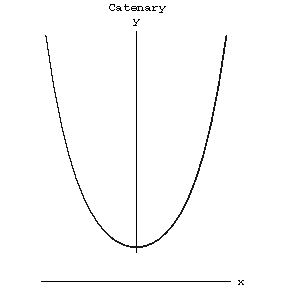Catenary
 From Encyclopedia of Mathematics - Reading time: 1 min
From Encyclopedia of Mathematics - Reading time: 1 min
The plane transcendental curve describing the form of a homogeneous flexible string of fixed length and with fixed ends attained under the action of gravity (see Fig.).

Figure: c020790a
In Cartesian coordinates its equation is
The length of an arc beginning at the point
The radius of curvature is
The area bounded by an arc of the catenary, two of its ordinates and the
If an arc of a catenary is rotated around the
References[edit]
| [1] | A.A. Savelov, "Planar curves" , Moscow (1960) (In Russian) |
| [a1] | J.D. Lawrence, "A catalog of special plane curves" , Dover, reprint (1972) |
🛠️ This page contains images that should be replaced by better images in the SVG file format. 🛠️
How to Cite This Entry: Catenary (Encyclopedia of Mathematics) | Licensed under CC BY-SA 3.0. Source: https://encyclopediaofmath.org/wiki/Catenary
38 views |
↧ Download this article as ZWI file
38 views |
↧ Download this article as ZWI file
 KSF
KSF